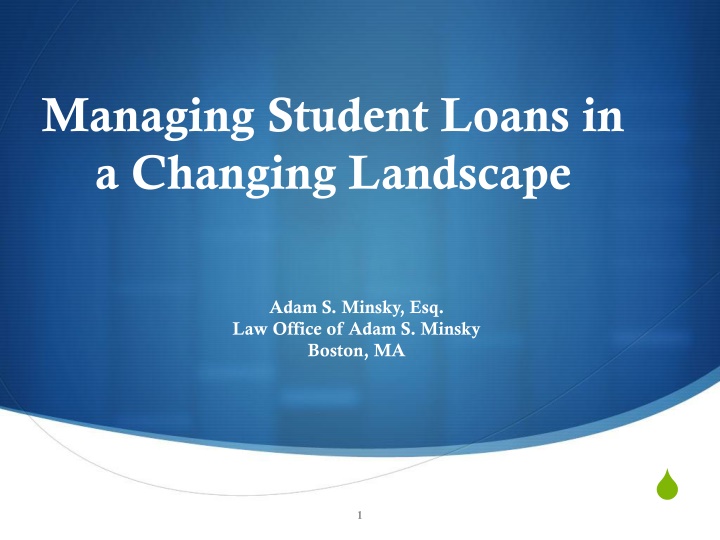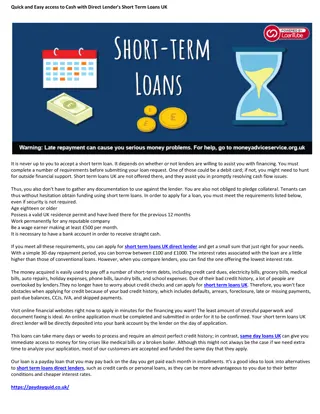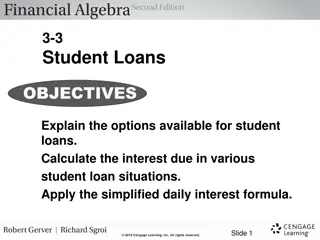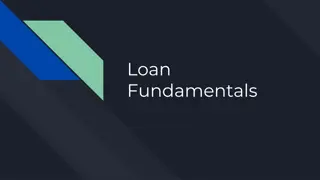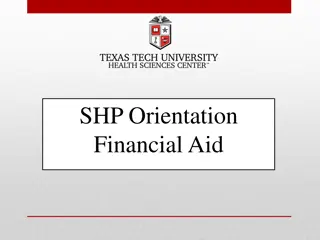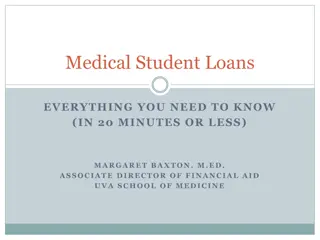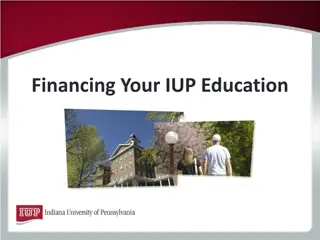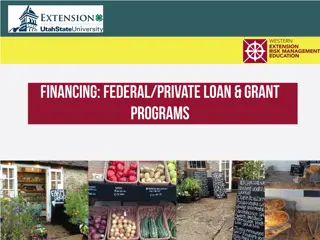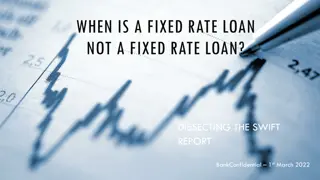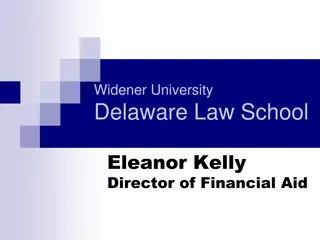Managing Student Loans in a Changing Landscape
Total outstanding student loan debt in the U.S. is $1.4 trillion, with approximately 44 million Americans having student loans. This article explores the types of student loans, key players involved, loan statuses, and options for postponing repayment. Understanding the loan landscape and knowing your rights and options are crucial in effectively managing student loans.
Uploaded on Mar 01, 2025 | 0 Views
Download Presentation

Please find below an Image/Link to download the presentation.
The content on the website is provided AS IS for your information and personal use only. It may not be sold, licensed, or shared on other websites without obtaining consent from the author.If you encounter any issues during the download, it is possible that the publisher has removed the file from their server.
You are allowed to download the files provided on this website for personal or commercial use, subject to the condition that they are used lawfully. All files are the property of their respective owners.
The content on the website is provided AS IS for your information and personal use only. It may not be sold, licensed, or shared on other websites without obtaining consent from the author.
E N D
Presentation Transcript
Managing Student Loans in a Changing Landscape Adam S. Minsky, Esq. Law Office of Adam S. Minsky Boston, MA 1
The Numbers Total outstanding student loan debt: $1.4 trillion Second-largest type of consumer debt (after mortgages) Total number of Americans with student loans: 44 million Approximately 1 in 9 Percentage of students graduating with debt: 70% Average 2016 undergrad student debt: $37,000. 2015 was $35,000. 2014 was $33,000. 2013 was $30,000. Percentage of borrowers in delinquency or default: 25% Sources: The Center for Financial Literacy, the Consumer Financial Protection Bureau, The Institute for College Access and Success, Edvisors, the Government Accountability Office, MarketWatch, Student Loan Hero, New York Fed 2
Types of Student Loans Student Loans Who is holding the loan: Government Entity Federal Private Private Lender Direct FFEL Perkins Institutional Traditional School Stafford PLUS Unsub Grad Parent Sub 3
Figuring Out the Type of Loan Private Federal Pull credit report. Check NSLDS (www.nslds.ed.gov) Requires FSA ID (different from Federal PIN). Review note, application, bills, and letters for name of lender, loan program. Review note, application, bills, and letters for name of federal loan program (i.e., Stafford or PLUS ) Look for a co-signer or option of one (much more likely to be present). * Few options to manage repayment *More options to manage repayment 4
Key Players Lender: The entity that originates the loan. For Direct loans, this is the Dept. of Ed. For FFEL loans, this is a commercial/private lender. Guarantor: For FFEL and some private loans only, the entity that "insures" the lender. Servicer: The entity that deals with day-to-day operations of the loan. Collection Agency: Represents the guarantor or lender when loan is in default (not on NSLDS). *Knowing who is handling the loan is important in understanding your rights and options 5
Possible Loan Statuses Grace Period Repayment / Current Deferment Forbearance Delinquency Default Knowing the loan status is also critical 6
Postponing Repayment Deferments (federal) A delay in repayment. Available deferments include: Student deferments for at least half-time study Graduate fellowship deferments Unemployment deferments (for up to three years) Economic hardship deferments (granted one year at a time for up to three years) 7
Postponing Repayment Forbearances (federal and private) The government does not pay interest during the forbearance period (for federal loans) Economic hardship forbearances available (up to three years) Significant interest consequences due to capitalization Can be retroactive to cancel out delinquency Private loan forbearance available, but very limited 8
Balance-Based Repayment (federal) Monthly payments made based on loan balance and interest rate. The general rule is the longer the repayment term, the lower the monthly payment, but the more you ll pay in total. Level: 10 year, 25 year, 30 year (limitations) Graduated: 10 year, 25 year, 30 year (limitations) Tip: Be wary of graduated plans! (Especially for law grads) 9
Income-Driven Repayment (federal) If borrower cannot afford balance-based payments on federal loans, consider income-driven repayment options Affordable payments even for large federal loan balances Better long-term solution than deferments and forbearance (which will run out) Poverty exemptions Progress towards loan forgiveness Interest subsidy on subsidized loans for first 3 years 10
Income-Contingent Repayment (ICR) Direct loans ONLY 20% of discretionary income, which is the difference between AGI and 100% of federal poverty level. 25-year repayment term, then remaining balance is forgiven. *Taxable? Example: Single borrower, $50,000 federal loan, AGI = $40,000. ICR payment = $445. Joint income of married borrowers, unless they file taxes separately ICR doesn t make sense for most borrowers, except certain Parent PLUS borrowers (must first consolidate) 11
Income-Based Repayment (IBR) Direct or FFEL loans. NO PARENT PLUS loans. 15% of discretionary income, which is the difference between AGI and 150% of federal poverty level. 25-year repayment term, then remaining balance is forgiven. *Taxable? Example: Single borrower, $50,000 federal loan, AGI = $40,000. IBR payment = $280. Joint income of married borrowers, unless they file taxes separately 12
Pay-As-You-Earn (PAYE) Direct Loans Only. NO PARENT PLUS loans. 10% of discretionary income. 20-year repayment term, then remaining balance is forgiven. *Taxable? Example: Single borrower, $50,000 federal loan, AGI = $40,000. PAYE payment = $190. Limited to new borrowers. No outstanding fed loan as of Oct. 1, 2007, and new fed loan on or after Oct. 1, 2011. Joint income of married borrowers, unless they file taxes separately (like IBR, ICR) Interest capitalization limited to 10% of original PAYE loan balance 13
Revised Pay-As-You-Earn (REPAYE) Eliminates new borrower restrictions placed on PAYE and New IBR 10% of discretionary income (just like PAYE) Some important differences from other plans: Only Direct Loans. Joint income for married borrowers regardless of tax filing 20-year repayment term for undergraduate loans. 25-year repayment term if borrower took out any graduate loans. Interest benefit 50% of interest waived during negative amortization 14
Public service loan forgiveness Only Direct Loans Must make 120 payments (10 years of payments) AFTER Oct. 1, 2007. Not retroactive. Payments must be made through eligible payment plans (10-year Standard, ICR, IBR, PAYE, or REPAYE). Can t be in default. Full-time, qualifying public service employment for each payment, and when borrower applies for forgiveness Can submit application to track payments Forgiven amount not taxable income 15
Teacher Loan Forgiveness Right type of loans Federal Stafford loans disbursed after 1998 Right type of teaching Specific type of teacher, specific type of school For right amount of time 5 consecutive years of service Forgiveness is capped at $5,000 or $17,500 Cannot make progress towards TLF and PSLF at the same time 16
Perkins Loan Forgiveness ONLY available for Perkins loans Be careful about consolidating! ONLY available for certain specific full-time professions: Nurse, medical technician, provider of early intervention services for the disabled, speech pathologists and special ed teachers in certain low-income schools or educational service agencies Can provide up to 100% forgiveness over 5 years, with no payments required Complete application through school (lender) or servicer 17
Repayment Assistance National Health Service Corps (NHSC) Competitive application process Must be dedicated primary care provider in medicine (MD, DO, NP, CNM, PA), dentistry (DMD, DDS, RDH), or mental health (HSP, LCSW, PNS, MFT, LPC) Must serve community in need at an NHSC-approved site with a minimum two-year commitment AmeriCorps, PeaceCorps Employer-based repayment assistance School-based repayment assistance 18
Refinancing / Consolidating through a private lender PROS: Potentially lower interest rate, better repayment terms (especially for high-interest private loans) CONS: If you refinance federal loans through a private lender, you forever lose out on federal student loan program benefits and consumer protections. Considerations: Interest rate, repayment terms/conditions, origination fees Rules of Thumb: Refinancing high-interest private loans = Good idea! Refinancing high-interest federal loans = It Depends. Consider life insurance and LTD insurance to mitigate some risks SoFi, Earnest, LendKey, Common Bond, DRB, Credible, some banks 19
Defining Default Private Federal The failure of a borrower and endorser, if any, to make an installment payment when due, or to meet other terms of the promissory note, if the Secretary finds it reasonable to conclude that the borrower and endorser, if any, no longer intend to honor the obligation to repay, provided that this failure persists for 270 days. Requires review of the promissory note, as default is defined by the terms of each individual loan. 34 C.F.R. 685.102 20
Consequences of Private Loan Default Negative credit reporting. Collection calls and letters. Assessment of late fees. Assessment of collection costs. Litigation in state court. Aside from bankruptcy restrictions, private default is not much different from defaulting on other unsecured consumer debt 21
Consequences of Federal Loan Default Negative credit reporting Denial of new federal aid Collection fees up to 25%. Forced Administrative Collections Treasury offset, wage garnishment Litigation (in a small number of cases) No statute of limitations applies. 22
Federal Default Resolution Discharge Disability, certain types of school misconduct Rehabilitation Temporary, 9-month repayment plan tied to income Consolidation New federal consolidation loan must select IDR plan Compromise/settlement Will not get pennies on the dollar 23
New Legislation Temporary Expanded Public Service Loan Forgiveness (TEPSLF) Addresses borrowers who were on the wrong repayment plan (but not borrowers who have the wrong loan) Discretionary fund established Exceptionally complicated Tax relief for federal discharge due to disability or death No longer treated as taxable income no 1099-C 24
Proposed Legislation White House budget proposal De-fund PSLF and eliminate IDR plans Would grandfather in current borrowers Was not included in Congressional budget PROSPER Act Repeals PSLF and eliminates IDR plans Eliminates Stafford and Grad PLUS loan programs Would grandfather in current borrowers Rumor is that this bill is effectively dead (for now) New rules from Dept. of Ed rescinding borrower protections Gainful Employment Borrower Defense to Repayment 25
Pending Litigation Commonwealth of Massachusetts v. PHEAA / FedLoan Accuses PHEAA of widespread servicing problems, particularly for borrowers seeking PSLF and IDR plans American Bar Association v. PHEAA and Dept. of Ed In response to PHEAA reversing PSLF decisions CFPB (and others) v. Navient Alleging widespread systematic servicing problems 26
Other Proposals and Potential Developments Automatic recertification for IDR plans Automatic payroll deductions for IDR plans Elimination of loan forgiveness tax for IDR plans Changing bankruptcy jurisprudence 27
Resources: www.studentaid.ed.gov www.studentloans.gov www.nclc.org www.ibrinfo.org www.nhsc.hrsa.gov 28
Get to know me: Web: www.minsky-law.com Blog: www.BostonStudentLoanLawyer.com LinkedIn: /AdamSMinsky Twitter: @AdamSMinsky Fbook: @BostonStudentLoanLawyer
Questions? Adam S. Minsky Law Office of Adam S. Minsky asminsky@minsky-law.com 30
